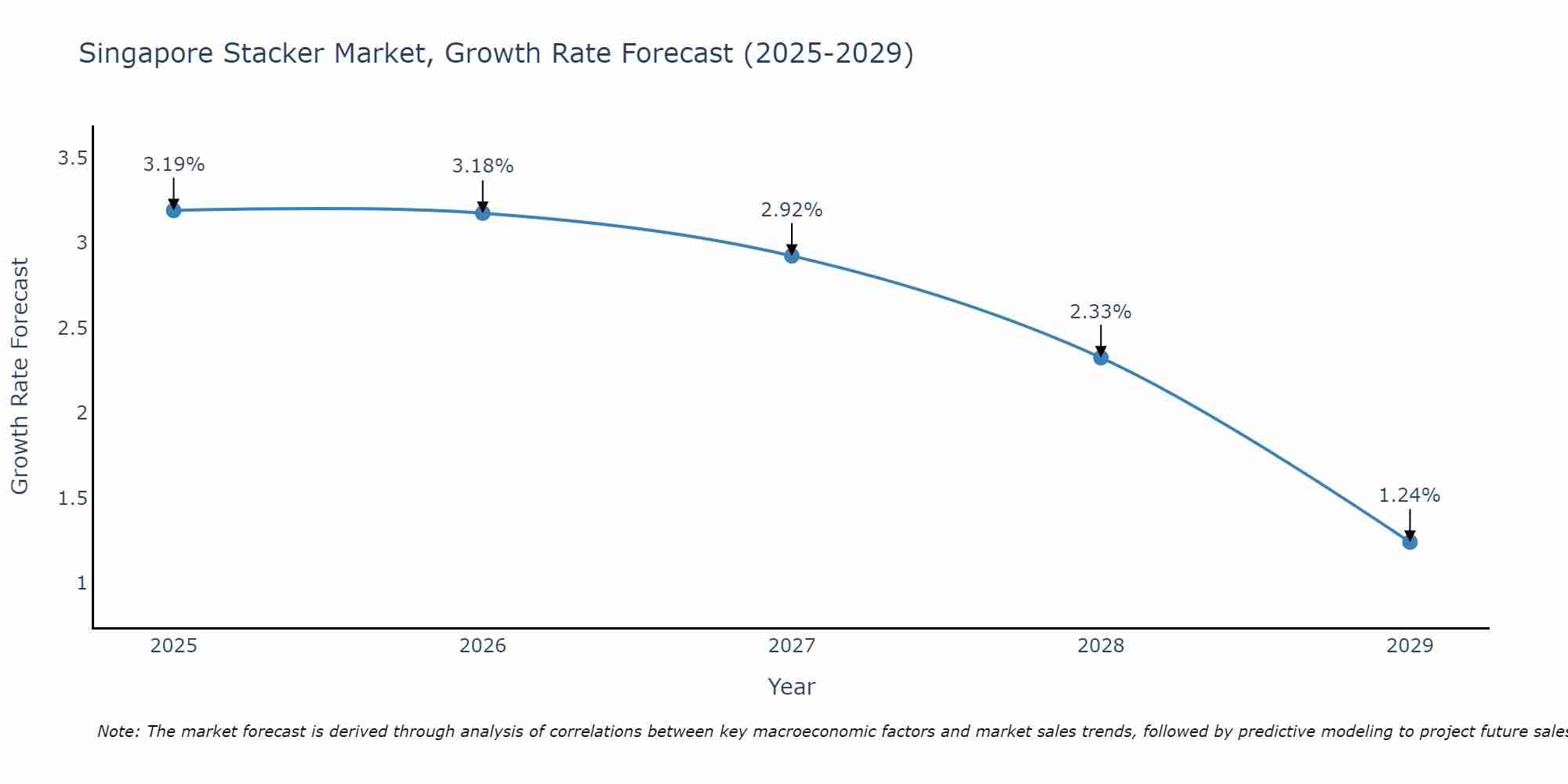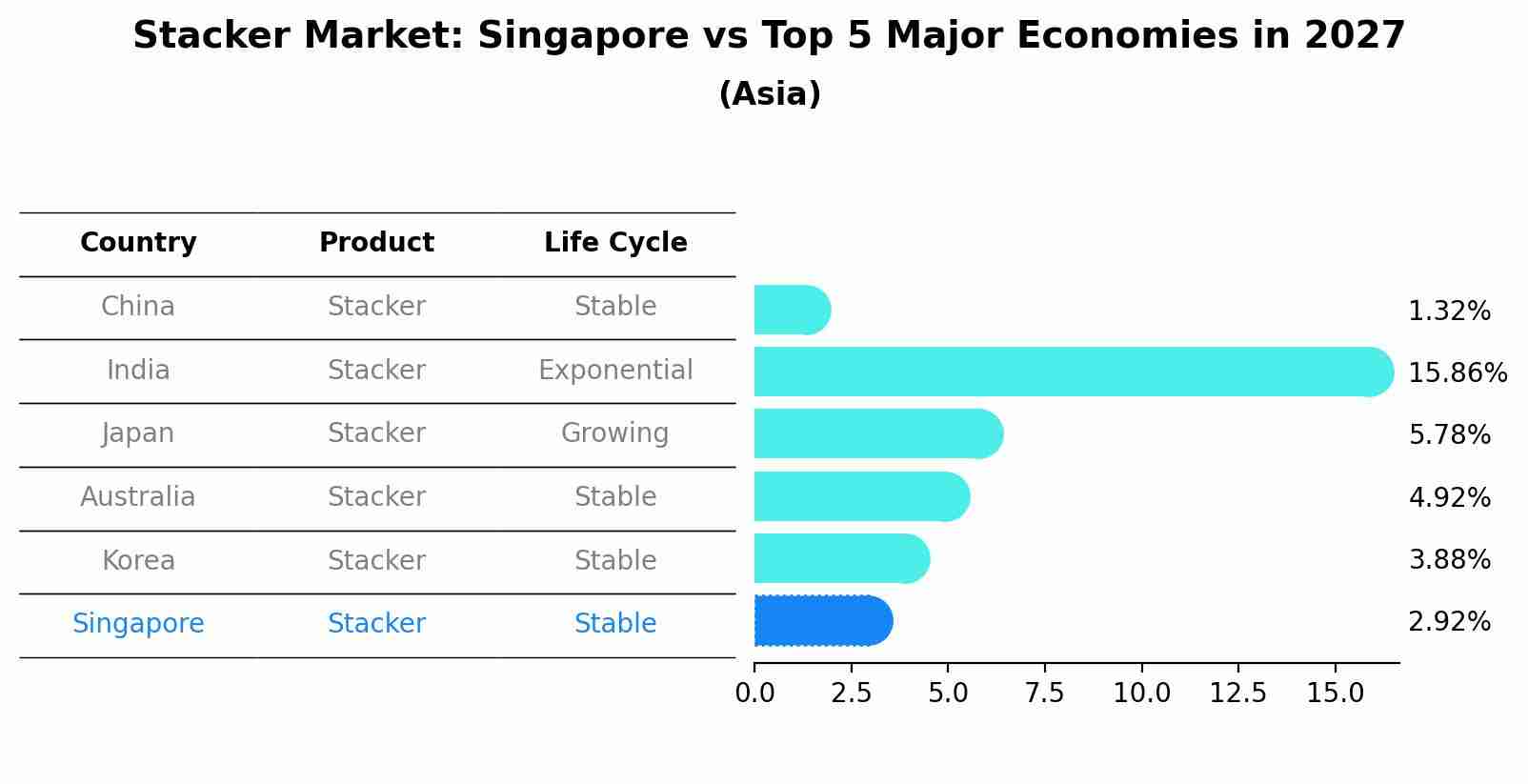Singapore Stacker Market (2025-2031) Outlook | Industry, Value, Share, Companies, Analysis, Growth, Trends, Size, Forecast & Revenue
| Product Code: ETC306687 | Publication Date: Aug 2022 | Updated Date: Aug 2025 | Product Type: Market Research Report | |
| Publisher: 6Wresearch | No. of Pages: 75 | No. of Figures: 35 | No. of Tables: 20 | |
Singapore Stacker Market Size Growth Rate
The Singapore Stacker Market may undergo a gradual slowdown in growth rates between 2025 and 2029. Starting high at 3.19% in 2025, the market steadily declines to 1.24% by 2029.

Stacker Market: Singapore vs Top 5 Major Economies in 2027 (Asia)
Singapore's Stacker market is anticipated to experience a stable growth rate of 2.92% by 2027, reflecting trends observed in the largest economy China, followed by India, Japan, Australia and South Korea.

Singapore Stacker Market Synopsis
The Singapore stacker market is closely tied to the region`s logistics and warehousing industry. As Singapore continues to be a major global hub for trade and commerce, efficient material handling and warehousing solutions are in high demand. Stackers, including both manual and automated variants, are integral to optimizing storage space and ensuring efficient supply chain management. With the increasing need for streamlined and cost-effective logistics operations, the stacker market is poised for steady growth. Furthermore, the incorporation of advanced technologies like automation and robotics in stacker systems is expected to enhance their efficiency and drive market expansion. The future of the Singapore stacker market remains robust, in line with the nation`s role in global trade.
Drivers of the Market
The Singapore Stacker Market is on the rise due to the country`s position as a logistics and trade hub. Stacker equipment is essential for efficient material handling in warehouses and logistics centers. Singapore strategic location for global trade has led to increased demand for stackers, driven by the need for smooth and swift cargo handling. Automation trends in logistics are also a significant factor contributing to the growth of this market.
Challenges of the Market
The stacker market encounters challenges linked to industrial automation and safety standards. As industries strive for greater automation and efficiency in material handling, there is a growing demand for advanced stacker solutions. Ensuring these stackers meet stringent safety regulations is essential. Moreover, training operators to use these machines safely and efficiently remains an ongoing challenge.
COVID-19 Impact on the Market
The Singapore stacker market faced challenges during the pandemic, primarily due to disruptions in supply chains and a slowdown in the logistics and warehousing sectors. With reduced demand for non-essential goods and a shift towards e-commerce, the need for stackers in warehouses fluctuated. Companies in this market had to adapt to changing market dynamics, focusing on providing efficient and automated solutions to cater to the growing e-commerce sector. As economic activities normalize, the stacker market is expected to regain its momentum.
Key Players in the Market
In the Singapore Stacker market, key players include companies like Toyota Material Handling Group, Crown Equipment Corporation, and Hyster-Yale Materials Handling, Inc. These companies offer a wide range of stacker and material handling solutions.
Key Highlights of the Report:
- Singapore Stacker Market Outlook
- Market Size of Singapore Stacker Market, 2024
- Forecast of Singapore Stacker Market, 2031
- Historical Data and Forecast of Singapore Stacker Revenues & Volume for the Period 2021-2031
- Singapore Stacker Market Trend Evolution
- Singapore Stacker Market Drivers and Challenges
- Singapore Stacker Price Trends
- Singapore Stacker Porter's Five Forces
- Singapore Stacker Industry Life Cycle
- Historical Data and Forecast of Singapore Stacker Market Revenues & Volume By Type for the Period 2021-2031
- Historical Data and Forecast of Singapore Stacker Market Revenues & Volume By Electric for the Period 2021-2031
- Historical Data and Forecast of Singapore Stacker Market Revenues & Volume By Manual/Hydraulic for the Period 2021-2031
- Historical Data and Forecast of Singapore Stacker Market Revenues & Volume By Semi-Electric for the Period 2021-2031
- Historical Data and Forecast of Singapore Stacker Market Revenues & Volume By End-User for the Period 2021-2031
- Historical Data and Forecast of Singapore Stacker Market Revenues & Volume By Retail & Wholesale for the Period 2021-2031
- Historical Data and Forecast of Singapore Stacker Market Revenues & Volume By Logistics for the Period 2021-2031
- Historical Data and Forecast of Singapore Stacker Market Revenues & Volume By Automobile for the Period 2021-2031
- Historical Data and Forecast of Singapore Stacker Market Revenues & Volume By Food & Beverages for the Period 2021-2031
- Historical Data and Forecast of Singapore Stacker Market Revenues & Volume By Others for the Period 2021-2031
- Singapore Stacker Import Export Trade Statistics
- Market Opportunity Assessment By Type
- Market Opportunity Assessment By End-User
- Singapore Stacker Top Companies Market Share
- Singapore Stacker Competitive Benchmarking By Technical and Operational Parameters
- Singapore Stacker Company Profiles
- Singapore Stacker Key Strategic Recommendations
Frequently Asked Questions About the Market Study (FAQs):
1 Executive Summary |
2 Introduction |
2.1 Key Highlights of the Report |
2.2 Report Description |
2.3 Market Scope & Segmentation |
2.4 Research Methodology |
2.5 Assumptions |
3 Singapore Stacker Market Overview |
3.1 Singapore Country Macro Economic Indicators |
3.2 Singapore Stacker Market Revenues & Volume, 2021 & 2031F |
3.3 Singapore Stacker Market - Industry Life Cycle |
3.4 Singapore Stacker Market - Porter's Five Forces |
3.5 Singapore Stacker Market Revenues & Volume Share, By Type, 2021 & 2031F |
3.6 Singapore Stacker Market Revenues & Volume Share, By End-User, 2021 & 2031F |
4 Singapore Stacker Market Dynamics |
4.1 Impact Analysis |
4.2 Market Drivers |
4.2.1 Increasing adoption of automation and robotics in various industries in Singapore |
4.2.2 Growing emphasis on workplace safety and ergonomics |
4.2.3 Rising demand for efficient material handling solutions in warehouses and logistics sectors |
4.3 Market Restraints |
4.3.1 High initial investment costs for stacker equipment |
4.3.2 Limited availability of skilled labor for operating stackers |
4.3.3 Regulatory challenges and compliance requirements in the material handling industry |
5 Singapore Stacker Market Trends |
6 Singapore Stacker Market, By Types |
6.1 Singapore Stacker Market, By Type |
6.1.1 Overview and Analysis |
6.1.2 Singapore Stacker Market Revenues & Volume, By Type, 2021-2031F |
6.1.3 Singapore Stacker Market Revenues & Volume, By Electric, 2021-2031F |
6.1.4 Singapore Stacker Market Revenues & Volume, By Manual/Hydraulic, 2021-2031F |
6.1.5 Singapore Stacker Market Revenues & Volume, By Semi-Electric, 2021-2031F |
6.2 Singapore Stacker Market, By End-User |
6.2.1 Overview and Analysis |
6.2.2 Singapore Stacker Market Revenues & Volume, By Retail & Wholesale, 2021-2031F |
6.2.3 Singapore Stacker Market Revenues & Volume, By Logistics, 2021-2031F |
6.2.4 Singapore Stacker Market Revenues & Volume, By Automobile, 2021-2031F |
6.2.5 Singapore Stacker Market Revenues & Volume, By Food & Beverages, 2021-2031F |
6.2.6 Singapore Stacker Market Revenues & Volume, By Others, 2021-2031F |
7 Singapore Stacker Market Import-Export Trade Statistics |
7.1 Singapore Stacker Market Export to Major Countries |
7.2 Singapore Stacker Market Imports from Major Countries |
8 Singapore Stacker Market Key Performance Indicators |
8.1 Average utilization rate of stacker equipment |
8.2 Percentage of downtime for stacker machines |
8.3 Average time taken for stacker equipment maintenance |
8.4 Number of accidents or safety incidents involving stacker operations |
8.5 Rate of adoption of automated stacker solutions in key industries |
9 Singapore Stacker Market - Opportunity Assessment |
9.1 Singapore Stacker Market Opportunity Assessment, By Type, 2021 & 2031F |
9.2 Singapore Stacker Market Opportunity Assessment, By End-User, 2021 & 2031F |
10 Singapore Stacker Market - Competitive Landscape |
10.1 Singapore Stacker Market Revenue Share, By Companies, 2024 |
10.2 Singapore Stacker Market Competitive Benchmarking, By Operating and Technical Parameters |
11 Company Profiles |
12 Recommendations |
13 Disclaimer |
- Single User License$ 1,995
- Department License$ 2,400
- Site License$ 3,120
- Global License$ 3,795
Search
Related Reports
- Australia IT Asset Disposal Market (2025-2031) | Strategy, Consumer Insights, Analysis, Investment Trends, Opportunities, Growth, Size, Share, Industry, Revenue, Segments, Value, Segmentation, Supply, Forecast, Restraints, Outlook, Competition, Drivers, Trends, Demand, Pricing Analysis, Competitive, Strategic Insights, Companies, Challenges
- UAE Building Thermal Insulation Market Outlook (2025-2031) | Revenue, Companies, Share, Trends, Growth, Size, Forecast, Industry, Analysis & Value
- Portugal Electronic Document Management Market (2025-2031) | Strategy, Consumer Insights, Analysis, Investment Trends, Opportunities, Growth, Size, Share, Industry, Revenue, Segments, Value, Segmentation, Supply, Forecast, Restraints, Outlook, Competition, Drivers, Trends, Demand, Pricing Analysis, Competitive, Strategic Insights, Companies, Challenges
- France Electronic Document Management Market (2025-2031) | Strategy, Consumer Insights, Analysis, Investment Trends, Opportunities, Growth, Size, Share, Industry, Revenue, Segments, Value, Segmentation, Supply, Forecast, Restraints, Outlook, Competition, Drivers, Trends, Demand, Pricing Analysis, Competitive, Strategic Insights, Companies, Challenges
- Portugal Occupational Health & Safety Services Market (2025-2031) | Strategy, Consumer Insights, Analysis, Investment Trends, Opportunities, Growth, Size, Share, Industry, Revenue, Segments, Value, Segmentation, Supply, Forecast, Restraints, Outlook, Competition, Drivers, Trends, Demand, Pricing Analysis, Competitive, Strategic Insights, Companies, Challenges
- Netherlands Occupational Health and Safety Services Market (2025-2031) | Strategy, Consumer Insights, Analysis, Investment Trends, Opportunities, Growth, Size, Share, Industry, Revenue, Segments, Value, Segmentation, Supply, Forecast, Restraints, Outlook, Competition, Drivers, Trends, Demand, Pricing Analysis, Competitive, Strategic Insights, Companies, Challenges
- Belgium and Luxembourg Facility Management Market (2025-2031) | Strategy, Consumer Insights, Analysis, Investment Trends, Opportunities, Growth, Size, Share, Industry, Revenue, Segments, Value, Segmentation, Supply, Forecast, Restraints, Outlook, Competition, Drivers, Trends, Demand, Pricing Analysis, Competitive, Strategic Insights, Companies, Challenges
- Russia Women Intimate Apparel Market (2025-2031) | Strategy, Consumer Insights, Analysis, Investment Trends, Opportunities, Growth, Size, Share, Industry, Revenue, Segments, Value, Segmentation, Supply, Forecast, Restraints, Outlook, Competition, Drivers, Trends, Demand, Pricing Analysis, Competitive, Strategic Insights, Companies, Challenges
- Africa Chocolate Market (2025-2031) | Size, Share, Trends, Growth, Revenue, Analysis, Forecast, industry & Outlook
- Global Hydroxychloroquine And Chloroquine Market (2025-2031) | Industry, Trends, Size, Outlook, Growth, Value, Companies, Revenue, Analysis, Share, Forecast
Industry Events and Analyst Meet
Our Clients
Whitepaper
- Middle East & Africa Commercial Security Market Click here to view more.
- Middle East & Africa Fire Safety Systems & Equipment Market Click here to view more.
- GCC Drone Market Click here to view more.
- Middle East Lighting Fixture Market Click here to view more.
- GCC Physical & Perimeter Security Market Click here to view more.
6WResearch In News
- Doha a strategic location for EV manufacturing hub: IPA Qatar
- Demand for luxury TVs surging in the GCC, says Samsung
- Empowering Growth: The Thriving Journey of Bangladesh’s Cable Industry
- Demand for luxury TVs surging in the GCC, says Samsung
- Video call with a traditional healer? Once unthinkable, it’s now common in South Africa
- Intelligent Buildings To Smooth GCC’s Path To Net Zero













